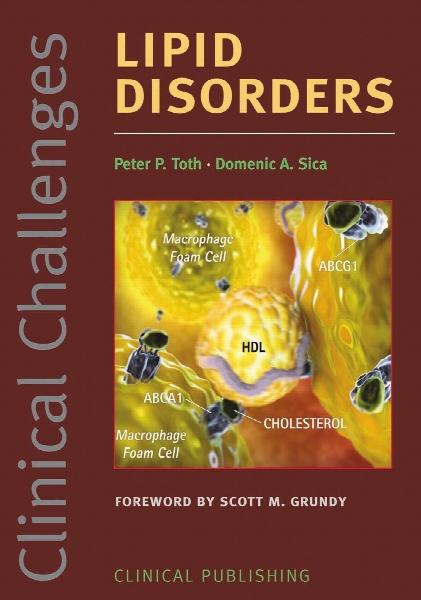Clinical challenges in lipid disorders
- نوع فایل : کتاب
- زبان : انگلیسی
- مؤلف : Peter P Toth; Domenic A Sica
- ناشر : Oxford ; Ashland, OH : Clinical Pub.
- چاپ و سال / کشور: 2008
- شابک / ISBN : 9781846920295
Description
1. What is the relationship between lipids and risk for cardiovascular morbidity and mortality? Kevin C Maki; 2. Framingham risk scoring or risk factor counting: which is more sensitive and how do I use this information to determine patient-specific lipid goals? Neil Stone; 3. What is the metabolic syndrome, how do I treat it, and is it a high risk condition? Kathleen Wynne; 4. Should all patients admitted to hospital with an acute coronary syndrome initiate statin therapy? Peter H. Jones; 5. What are CAD risk equivalents and how did these clinical entities come to be so defined? Michael Clearfield; 6. When should children and adolescents be screened for dyslipidemia and how should they be treated? Stephen R. Daniels; 7. Do statins reduce cardiovascular morbidity and mortality in women? How does lipid management in women differ from that in men? Emma Meagher; 8. In high and very high risk patients, is it true that when it comes to LDL-C, lower is better? Can a serum LDL-C be driven too low? Michael H. Davidson; 9. Why do statins place patients at risk for myalgia, myopathy, and rhabdomyolysis? What is the risk for these complications and, if encountered, how should they be managed? Does coenzyme Q supplementation have a role in relieving myalgia? Peter Toth; 10. What are the so-called pleiotropic effects of statins, and do they make a difference in cardiovascular outcomes? James K. Liao; 11. What specifically constitutes therapeutic lifestyle change? Do diet, weight loss, and exercise meaningfully impact serum lipid levels and risk for cardiovascular disease? Margo A. Denke; 12. What is non-HDL? When should patients be treated with a fibrate? How do fibrates work and do they significantly impact risk for cardiovascular morbidity and mortality? Can fibrates be combined with a statin? James McKenney; 13. In diabetic patients, do the thiazolidinedione drugs beneficially impact lipid levels? Are these changes in lipids correlated with cardiovascular benefit in clinical trials? W Virgil Brown; 14. How does niacin work? When should I use it and what can be done to reduce the frequency and severity of flushing? Does niacin augment the capacity of a statin to reduce cardiovascular events? Eliot A. Brinton; 15. Which nutraceuticals and dietary supplements have proven efficacy for impacting serum lipids and cardiovascular outcomes? Penny Kris-Etherton; 16. Why do lipid lowering agents affect serum transaminase levels? Are these drugs toxic to the liver and can they precipitate liver failure? Arun Sanyal; 17. Should I treat a low serum HDL-C? What specific lifestyle changes and drugs can be used to raise a low HDL-C? Antonio M. Gotto; 18. What is familial hypercholesterolemia and how should it be treated? Patrick Moriarty; 19. Should I measure serum levels of lipoprotein(a)? Why is it believed to be atherogenic? If it is elevated, how should it be treated? Marlys Koschinsky; 20. What is advanced lipid testing? Which patients should have this done and how do I decide which test is most appropriate for my patient? William Cromwell; 21. Should we treat dyslipidemia in the elderly? Is there an upper age limit to instituting lipid-lowering therapy? Jennifer Robinson; 22. What do I do with statin therapy in the patient with renal failure? Domenic Sica; 23. Do diuretics and beta-blockers adversely affect components of the lipid profile and, if so, how is this best managed? Daniel J. Wilson; Abbreviations; General index.
Aims to demonstrate to the reader that any clinical problem is likely to have several alternative solutions and that rarely do they present as the textbook example. This title reviews complex manifestations of lipid disorders. It presents alternative management strategies. It also presents treatment options for specific patient groups.


